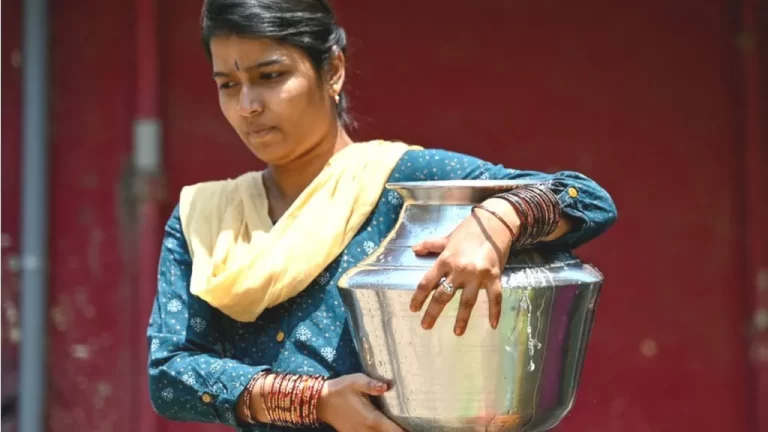In India's Bengaluru city (formerly Bangalore), thousands of people have been chasing tankers, taking fewer showers and sometimes missing work to store enough water to get through the day.
The southern metropolis – once called a pensioners' paradise because of its cool weather and lush gardens – is now more famous as India's info-tech hub where companies like Infosys, Wipro and hundreds of start-ups have plush offices. But years of rapid, often unplanned, expansion have taken a toll, and the city now appears bursting at its seams.
“It is often said that traffic is the biggest problem in Bengaluru but actually water is the larger issue,” says civic activist Srinivas Alavilli.
Bengaluru's 15 million people need at least two billion litres of water every day – more than 70% of this comes from the Cauvery river. The river originates in Karnataka state (of which Bengaluru is the capital) and has been at the centre of a water-sharing dispute with the neighbouring Tamil Nadu state for more than a century.
The remaining 600 million litres come from groundwater extracted by borewells and supplied via tankers, which are a lifeline for people in the peripheral areas of the city. But a weak monsoon last year depleted groundwater levels, which means new borewells have to be dug deeper to find water. This has led to a daily shortfall of 200 million litres in water supply.
To counter this, officials have announced measures ranging from regulating tanker prices to levying fines on people who use drinking water for gardening and washing vehicles. Some conservation experts have criticised the order, asking how officials expect to “police every household”.
While the shortage is being felt across the city, the brunt is being borne by people living in the outskirts of Bengaluru, especially in 110 villages that were merged with the city in 2007.
People living in apartment buildings and gated communities say they are being forced to change their routines, especially at a time when temperatures are unusually high in what was once known as one of India's coolest cities.

In some apartments, residents' welfare associations have asked people to wash their cars not more than twice a week, use just half a bucket of water to bathe and use half-flush in the toilet.
BBC Hindi spoke to residents of some buildings in Somasundarapalya, a few kilometres from the upscale HSR layout where many tech workers live. Most of the tenants in these buildings work as cooks and security guards.
A man who did not want to be named said the caretakers of his building had stopped pumping water to the topmost four floors.
“We have to collect water in buckets from a storage tank in the building and carry them all the way up to our houses. This is to ensure that we use less water,” he said. The manager of the buildings, Nagaraju (who uses only one name), said that all the three borewells they were using had gone dry.
“We are getting supplies through five tankers, each of which brings in 4,000 litres. Earlier, we used to pay 700 rupees [$8.45; £6.60] per tanker. Now, it's gone up to 1,000 rupees,” he said.
Some villages on the city's periphery, adjoining the IT hub of Mahadevapura, have been receiving water every day from the Cauvery, the result of a government decision some years ago to divert additional water from the river.
But even this supply has not kept pace with the influx of new residents and the construction of buildings to house them, and people there too have to pay for water tankers.
Ruchi Pancholi, who works for a global tech company in the software hub Whitefield, says this unprecedented construction has also led to more borewells being installed and an overexploitation of groundwater.
Some have also expressed concerns that the situation is likely to worsen as summer peaks, but officials say it will get better in the next couple of months. The fifth phase of the project to supply the city with water from the Cauvery river is scheduled to be completed by May and is expected to ease the problems faced by people living on the outskirts.
Top officials say Bengaluru's population growth has surpassed all projections made during the commissioning of the various stages of the Cauvery water project.
“Overall, there is tremendous pressure on the Cauvery water supply system,” says Ram Prasath Manohar V, chairman of the Bangalore Water Supply and Sewerage Board (BWSSB). Tushar Girinath, a former chairman of the board, says that phase five of the Cauvery project was expected to meet the city's water needs until 2035-40.
“But that will not be possible given the rate at which the city is growing. I don't anticipate it going beyond 2029,” he says.
Some activists are also calling for increased efforts to rejuvenate Bengaluru's dying lakes.
The crisis has also turned into a political battle between the state's governing Congress party and the opposition Bharatiya Janata Party (BJP) with general election just weeks away. While the BJP has held several protests blaming the government, the Congress has accused the BJP-ruled federal government of not providing financial assistance to drought-hit Karnataka.

Reports say the water shortage has slowed down production at factories and forced some tech workers to skip office meetings. Brand expert Harish Bijoor says while the crisis may not immediately affect Bengaluru's reputation as an investment destination, it should be treated as a “wake-up call”.
“We are heading towards uncertainty in the future. We can't afford that in terms of Brand Bengaluru, because people will think before making an investment here,” he says. In the meantime, Ms Pancholi has a question for the city's current and former administrators: “Why were buildings constructed before creation of basic infrastructure like providing potable water?”
— CutC by bbc.com


